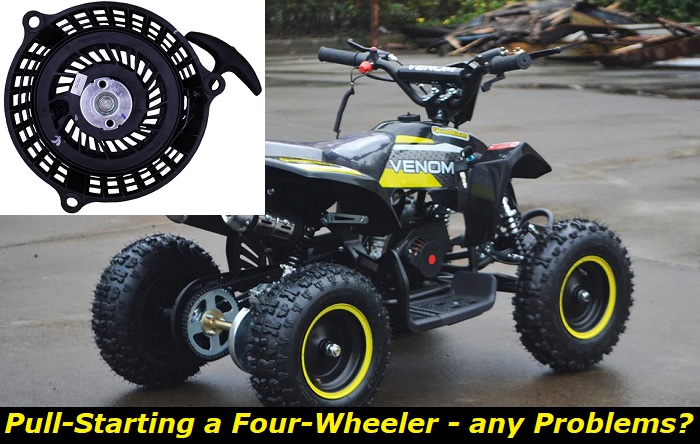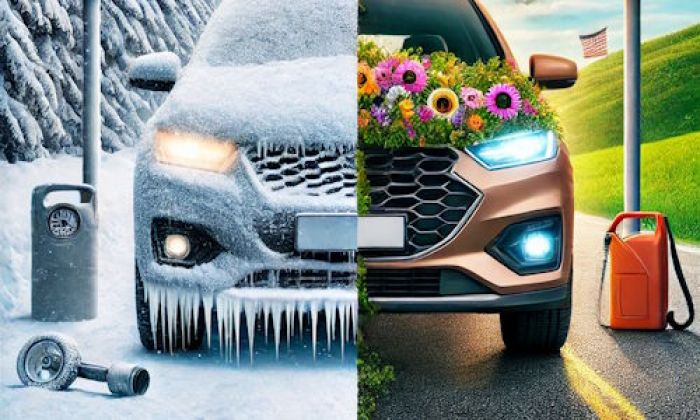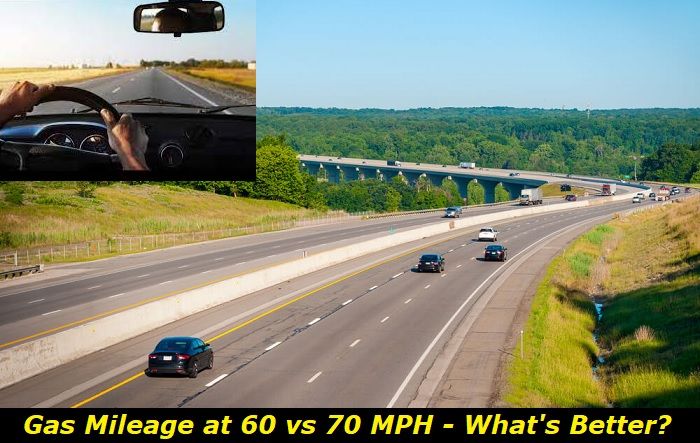Most four-wheelers now come with a switch or button for you to conveniently start their engine. However, there may be times when starting an ATV will fail mainly due to a faulty switch or button. In some cases, there may be other problematic parts preventing you from doing so.
Luckily, most of them still come with a backup featuring an old-school pull start mechanism. When all else fails, this is a handy way to get your ride running again until you fix whatever is hindering you from using its ignition switch or button.

Most Common Scenarios Where There's a Need to Pull Start a Four-Wheeler
There are many reasons why you may need to pull start your ATV. Here are ten of the most common scenarios where this will surely come useful:
1. Natural Battery Drain
The battery in your ATV weakens over time, so there may come a point when it may not be able to generate enough power to start the engine by pushing a button or turning the ignition key. In such cases, you will need to use the pull start mechanism.
2. No Power from the Battery Due to the ATV Sitting Idle for an Extended Period
When your ATV has been sitting idle for an extended period of time and hasn't been used at all, it may not have enough energy stored in its battery to turn on with a push of a button. Pull starting it can help overcome this issue.
3. Water Seepage
Pull starting your ATV may become necessary when there is water seepage inside its cowlings which affects certain systems like electricals, electronics, and fuel injection systems due to corrosion. Starting it using the pull start will help restore functionality to these systems.
4. Too Much Fuel in the Carb
If you accidentally flood your ATV due to too much fuel in the carburetor, this can cause a stall when starting with the ignition key or push button. Pull starting it will help get rid of the extra fuel and allow the engine to start normally again.
5. There's a Need to Clear a Clog in the Engine
When attempting to switch on your ATV after a long trail ride, there may be dirt particles that have collected inside its air intake system over time causing clogging which affects its performance. Pulling it can help clear out these particles and enable the engine to kickstart without any issues.
6. General Mechanical Issues
If there's a mechanical issue with your ATV that needs to be fixed, it might prevent the engine from starting with the ignition key or push button mechanism. This could require you to resort to the pull start option to get things going again.
7. Electrical Issues
If the connections between the battery and starter motor have become loose over time due to wear and tear, this could cause difficulty while attempting to start your ATV using the ignition key or push-button mechanism. Pull starting the ATV can help fix this issue.
8. Problem in the Fuel Injection System Prevents Proper Starts
When the fuel injection system isn't working properly and is unable to supply sufficient fuel for ignition, you might have no other option but to resort to pull starting the ATV in order to get it running again.
9. Flooding
If your ATV has been completely submerged in water due to accidental flooding, it could prevent its engine from kicking on with the ignition key or push button mechanism. Pull starting can then be done as a last-ditch effort to try and get the engine going again.
10. Normal Start is Disabled by a Security Feature
Many ATVs come with a security feature that prevents them from being started without the key. If this happens for some reason, then pull starting your vehicle can help get it running again until you can find a way to make it work with the key.
Knowing these scenarios will hopefully help you understand better why pull starting may be necessary at times.
Pull Starting a Four-Wheeler: The Step-by-Step Process
Now that you know why and when you may need to pull start your ATV, here is a step-by-step guide on doing this:
Step 1: Check Whether Your ATV Comes with a Pull Start Mechanism
The first thing to do is to check if your ride has such a mechanism or not. Most modern four-wheelers come with one on the left side of your foot when riding the four-wheeler. However, it should be noted that there are still some models that don't. In some cases, you may need to remove a panel on your engine to gain access to the pull start handle.
Step 2: Get in Position
Once you have found the pull start mechanism, you need to stand on the left side (or right if the mechanism is located on the right) of your ATV facing the front and grab hold of the handlebar firmly with both hands while making sure your feet are firmly planted on the ground. Make sure you are well-balanced before proceeding further.
Step 3: Pulling Action
Now comes the most important step, and that's pulling! You will need to keep steady pressure on the handlebar while simultaneously pulling on the rope firmly, with one swift and powerful movement.
Step 4: Start the Engine
If you have done it correctly, you should hear the engine coming to life! If this doesn't happen in one go, try again until you succeed.
Optional: Attach a Strap to the Pull Start
To get more momentum or if you find that the pull start cord is too short, you may need to attach a strap or rope to it for extra leverage. Just make sure that the new attachment is securely fitted in place. This is necessary as it will help generate enough force for starting the engine. Once your ATV has started, make sure to disconnect and secure any strap or rope that was attached to the pull start for safety purposes.
Important Things to Remember When Pull Starting a Four-Wheeler to Avoid Damage
There are some important things that you have to bear in mind when going through this process to avoid damaging your vehicle, especially the engine.
- Make sure to use sufficient force when pulling the rope. Pull too hard and you could potentially cause irreparable damage to your engine or transmission system.
- Do not keep trying to pull start the ATV if it isn't working after multiple attempts, as this could be a sign of something else being wrong and you may need professional help in that case. Continuing further may ruin the cord, pulley, or other parts linked to your ride's pull start mechanism.
- Connect a strap or rope to the pull start handlebar for extra leverage if needed. Just make sure that the attachment is securely fitted in place.
- Remember to remove any strap or rope attachments after starting your vehicle for safety reasons.
How to Get the Start Switch/Button Working Again
Frequent pull starting can be a tedious affair, especially if you are not used to it. It may also cause undue stress to the mechanical components of your ride, particularly the engine and transmission.
If you want to get the start switch/button working again, here are some helpful tips that may come in handy:
- Inspect the battery and see if it needs a recharge or replacement. A faulty battery is one of the most common reasons why a vehicle won't turn on with its start button.
- Evaluate the other parts of your four-wheeler's charging system, especially the stator.
- Check for any loose or corroded wiring connections and make sure all the cables are securely connected and in working order.
- Examine the spark plugs and make sure they are clean and in good condition. Dirty or damaged spark plugs will prevent your engine from starting up properly.
- Check whether there is enough fuel in your four-wheeler as insufficient fuel can also cause the engine to not start. Likewise, a bad batch of fuel reserves can also prevent your ride from starting properly.
- Replace the key, start button, or switch if needed.
If all these steps fail, then you may need to consult a professional mechanic or technician who can inspect and troubleshoot your vehicle's electrical and mechanical systems for any underlying issues. By following these tips and instructions, you will be able to successfully start your ATV whenever needed, as well as get the essential start switch/button working again so that you don't have to rely on pull starts alone.
Conclusion
Pull starting is a fast and efficient way of getting your four-wheel ride up and running again, especially when you are facing certain issues or malfunctioning parts that prevent the use of the regular starting system. It can also be useful in cases where the battery power is low on charge.
Be sure to follow the instructions above carefully when attempting to pull start your vehicle, and make sure it's done in a safe environment. For uncertainty about the process, seek further assistance from your trusted mechanic or consult your four-wheeler's vehicle manual for more information.
About the authors
The CarAraC research team is composed of seasoned auto mechanics and automotive industry professionals, including individuals with advanced degrees and certifications in their field. Our team members boast prestigious credentials, reflecting their extensive knowledge and skills. These qualifications include: IMI: Institute of the Motor Industry, ASE-Certified Master Automobile Technicians; Coventry University, Graduate of MA in Automotive Journalism; Politecnico di Torino, Italy, MS Automotive Engineering; Ss. Cyril and Methodius University in Skopje, Mechanical University in Skopje; TOC Automotive College; DHA Suffa University, Department of Mechanical Engineering






Add comment